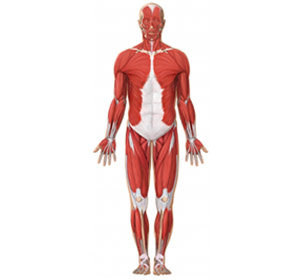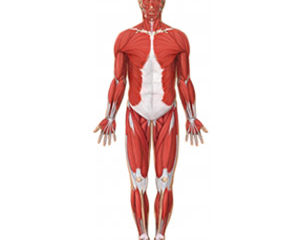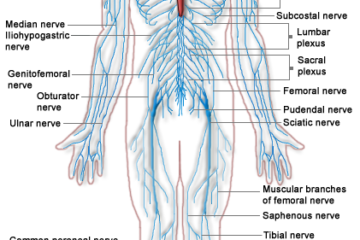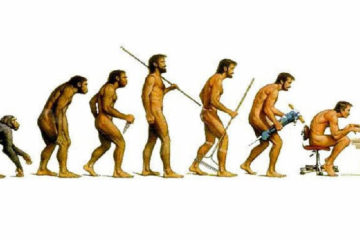The human body must obey certain physical laws in order to survive its environment.
These laws act on the body and trigger compensatory neurological and muscular activity, which commonly result in distortions of the human skeleton and muscle over activity known as muscle spasm. The resultant dysfunctions may include chronic pain, weakness and limited range of motion. However, by understanding a few key principles of biomechanics, many of these functional disturbances can be easily understood and corrected.
“The simple act of standing results in excessive muscular activity that distorts skeletal alignment, all in reaction to the initial simple forward rotation of the right hip.”

First, we will examine these physical laws and their effects on the biomechanics (movement) of the human body. The first law is the law of gravity. Gravity compresses us at a rate of 3.5 pounds per square inch. To illustrate the effect of gravity on the human skeleton, one may consider that we carry on our heads the equivalent weight of ten telephone books.
Our nerves, muscles and joints must continually respond to the demands of gravity. Had we evolved in a state of zero gravity, the body would have developed a very different set of compensatory reactions to changes in its physical environment. The second law states that for every action there is an equal and opposite reaction. In terms of biomechanics, for every movement or muscular contraction, there will be a compensatory reaction.
The human body responds to these physical laws in predictable ways. These responses may be understood in terms of two primary forces. Firstly, the body-gravity-center in a normally aligned human skeleton is located midway between the hips at the level of the second sacral vertebra. This location is affected by the position of the hips. The hips must be horizontally level in order to maintain the gravity center in its correct location. Hip position determines the susceptibility of the body to injury and its ability to cope with the various stresses of daily life.
Therefore, level hips are the foundation of mechanical balance in the body. Secondly, the “righting reflex” is achieved by a series of neuromuscular interactions that respond to the body-gravity-center and result in positioning the eyes on a horizontal plane. (If the head is tilted or angled downward, such that the eyes are not horizontally level and facing forward, the righting reflex will be activated. This reflex involves a system of constant communication that between the pelvis (that is, the body-gravity-center) and the eyes.
Spasticity in the muscles between the pelvis and the head is a result of the righting reflex triggering muscle over activity in an attempt to keep the eyes horizontally level. (If the righting reflex did not operate and the eyes were permitted to deviate from the horizontal, forward gaze, dizziness would result and function would be compromised.) Thus, the righting reflex responds to hip position and the body-gravity-center, guaranteeing that the eyes will stay level horizontally. This means that if the hips fall out of correct alignment, the body will compensate by making further adjustments in the hips, trunk, shoulders and neck in order to achieve the eyes on the necessary horizontal plane. Unfortunately, most of us do not have level hips. These compensatory adjustments may be called mechanical distortions, as they further alter body alignment from the normal.
To illustrate the neuromuscular therapy approach to muscular pain, we will look at the most common bodily distortion and its effect on the body in the reclining position, while standing and while walking. In the most common bodily distortion, the right hip is rotated forward approximately ¼ inch to 1 inch more that the left hip. This occurs because there is frequently a tendency to use the right leg more than the left leg, for instance, as in the operation of an automobile with automatic transmission. In this case, use of the right leg activates the muscles of the right hip, causing these muscles to shorten and consequently to pull the hip forward. The effects of this mechanical distortion may be clearly seen by examining the subject in various positions.
In the supine (reclining) position: When the subject lies on his back, the right leg will extend further forward than the left leg, making the right leg appear longer that the left leg. This is not because of an anatomical discrepancy in leg length, but because the right femur (thigh bone) extends from the right hip which, in our subject, is rotated forward. In the standing position: When the subject is standing, he will automatically shift his weight onto the functionally shorter left leg. This tilts the pelvis to the left, pulling the spine and head also to the left. This change in head position will involve the righting reflex, which will be called into action to reestablish the eyes on the horizontal plane.
This neuromuscular reflex will be carried out as follows: The nervous system will send impulses to muscles on the right side of the trunk to contract, thereby pulling the spine and head to the right, as a reaction to the left tilt of the hips. Next, the nervous system will recruit muscles between the left shoulder and neck to pull the head back to center to level the eyes. While the subject is standing, his right hip will be higher than the left hip, and his left shoulder will be higher than the right shoulder.
Most people fit this pattern. The simple act of standing results in excessive muscular activity that distorts skeletal alignment, all in reaction to the initial simple forward rotation of the right hip. The person may not suffer pain at the moment, but eventually this constellation of distortions in skeletal alignment will result in some degree of chronic debility and pain.
In walking: Recall that we have discovered that our subject has functional right. These muscular adjustments occur with every step one takes. In addition, the skeletal distortion (that is, hips pulled to the left and upper body pulled to the right), when the subject walks, will send shock waves up and down the spinal cord itself, resulting in tightening of the connective tissue around the spine, called the “dura matter,” and triggering muscle spasm in various parts of the body.
How is muscle spasm different from normal muscle activity? In normal muscle activity, muscle fibers alternately elongate and contract. When a muscle is over stimulated by trauma or overuse, the resultant muscle contractions are not followed by the normal relaxation. The muscle remains shortened and is unable to lengthen, as it should. This occurs because the nervous system receives signals from the overused muscle and, as a mechanism of defense against further muscle overuse and injury, the nervous system will trigger a “protective muscle spasm reflex” in the affected muscle. Neural impulses from the spastic muscle will feed into the central nervous system. This barrage of neural activity originating in the spastic muscle will result in further stimulation of the spastic muscle by the central nervous system, reinforcing the muscle spasm and preventing muscular relaxation and elongation.
This positive feedback loop prevents muscle relaxation in the spastic muscle and is called the hyperactive reflex arc. In this reflex arc, neural impulses from the spastic muscle stimulate the central nervous system, and the central nervous system responds by stimulating further contraction in the spastic muscle. This reflex arc is indefatigueable and therefore may persist for months or years, leading to chronically spastic muscles and associated pain.
In addition, chronic muscle spasm may result in other harmful physiological effects. In particular, spastic muscles may have deleterious effects on muscles and joints. Spastic muscles compress and constrict blood vessels, diminishing circulation to the affected muscles. This reduces the supply of oxygen and nutrients to the muscle cells and results in the buildup of toxic metabolites, such as lactic acid. The buildup of lactic acid causes nerve irritation in the muscle tissue, contributing to pain.
The spastic muscle develops ischemia (oxygen deprivation) and nutrient depletion, provoking tissue injury and poor healing. Spastic muscles also compress the joints, increasing the pressure on the joints during movement. This may affect any joint in the body. The knee, hip and shoulder joints are particularly vulnerable to the compressive effects of chronic muscle spasm in the muscles that border and support these joints. Gradually, the joint may deteriorate and wear out. In extreme cases, joint replacement may be necessary.
Spastic muscles also elicit signals from the central nervous system that may inhibit and weaken other muscles. The muscular state is thrown out of balance; some muscles overwork while other muscles are inhibited. This results in inefficient mobility, excessive energy consumption, exhaustion and pain. Activities of daily life may contribute to muscular imbalance.
Activities such as long sessions spent at a desk or computer, commuting by car or a lack of regular physical exercise may involve overuse of certain muscles and neglect of others. This may in turn lead to abnormal hip rotation and subsequent skeletal distortions and muscle spasms, as previously discussed.


